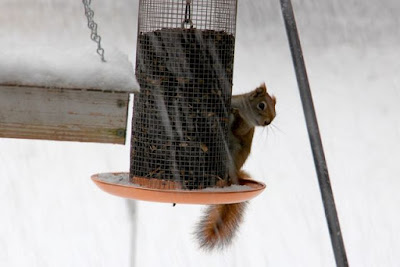 |
| red squirrel at Winter feeder
Photo by J. Harrington
|
After watching the dogs and their paws this week during our walks in this cold spell, I tried to find a description of adaptations the red squirrels might have evolved to scamper about as much as I see them these bitter days. No luck. Bernd Heinrich, in Winter World, writes that:
"Red squirrels are emphatically active any month of winter. They appear not to hibernate at all. However, during periods of extreme cold, the woods are silent, and they hole up for days at a time in their subterranean burrows under a stump or tree roots."The quotation, in combination with the number of locally active red squirrels this week, would seem to call into question the definition of "extreme cold," at least as used by red squirrels. Wild Mammals of New England, Alfred J. Godin, has an extensive description of red squirrels that hints extreme cold may be around -25℉. It also notes that breeding season starts in a week or so and peaks from next month into Spring. That helps explain the lack of hibernation, I suppose.
 |
| red squirrel on deck teasing the dog
Photo by J. Harrington
|
Active squirrels throughout the year are a continuing source of amusement for me and befuddlement for Franco, our border collie cross, who hasn't yet caught onto the tree-climbing routine. He charges out to herd the squirrels who, by the time he's turned the corner, have scampered for the heights. The dog looks around, sniffs, looks up and barks. Perhaps he feels that he's done his job of keeping the area safe from squirrels and tigers.
Finally, for those who honor it, enjoy this Feast of the Epiphany!
My Dog Practices Geometry
By Cathryn Essinger
I do not understand the poets who tell methat I should not personify. Every morningthe willow auditions for a new roleoutside my bedroom window—today she isClytemnestra; yesterday a Southern Belle,lost in her own melodrama, sinking on her skirts.Nor do I like the mathematicians who tell meI cannot say, "The zinnias are counting on theirfingers," or "The dog is practicing her geometry,"even though every day I watch her usingthe yard's big maple as the apex of a trianglefrom which she bisects the circumferenceof the lawn until she finds the place wherethe rabbit has escaped, or the squirrel uppedthe ante by climbing into a new Euclidian plane.She stumbles across the lawn, eyes pullingher feet along, gaze fixed on a rodent workingthe maze of the oak as if it were his own invention,her feet tangling in the roots of trees, and tripping,yes, even over themselves, until I go out to assist,by pointing at the squirrel, and repeating, "There!There!" But instead of following my outstretchedarm to the crown of the tree, where the animal isnow lounging under a canopy of leaves,catching its breath, charting its next escape,she looks to my mouth, eager to read my lips,confident that I—who can bring her homefrom across the field with a word, whocan speak for the willow and the zinnia—can surely charm a squirrel down from a tree.
********************************************
Thanks for visiting. Come again when you can.
Please be kind to each other while you can.
No comments:
Post a Comment